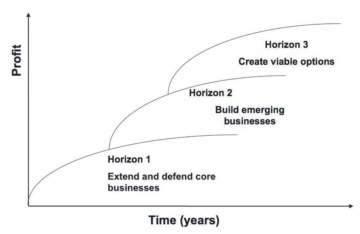 Our experience from working with Swedish companies in developing their strategies, skills and mindset of working with innovation is following: They are great in facing the operational challenges of today and to discuss strategies of the distant future, but the gap in between, where the journey from today to the future will take place, many companies are lost. A methodology for working with both present, future and the time in between is Three Horizon Methodology for Innovation.
Our experience from working with Swedish companies in developing their strategies, skills and mindset of working with innovation is following: They are great in facing the operational challenges of today and to discuss strategies of the distant future, but the gap in between, where the journey from today to the future will take place, many companies are lost. A methodology for working with both present, future and the time in between is Three Horizon Methodology for Innovation.
Applying the Three Horizon Methodology for Innovation
To become increasingly alert to market challenges, social shaping, emerging technology and other discoveries that might lead to new horizons, we need to connect what we do (or not do) ‘today’ with ‘possibilities’ in the future. Opportunities and challenges, often emerging, can be difficult to handle in existing organizations as they offer both conflicts and uncertainties. The way to counter concerns and handle the situation is to build an ongoing dialogue across the organization and to frame your innovation needs across the entire innovation / business portfolio.
The value of applying the Three Horizon Methodology for Innovation
Thinking in different horizons prompts you to go beyond the usual focus of fixing innovation just in the present. The Three Horizons Methodology connects the ‘present’ with the ‘desired future’ and identifies the ‘seen disruptions’ which might occur in moving towards a vision. This way of thinking first emerged in the late nineties through the work of Baghai, Coley and White (1999) and it has been further developed by a range of practitioners such as Andrew Curry, Anthony Hodgson and Bill Sharpe (2008) and the International Futures Forum, based in Scotland.
The methodology lends itself well for mapping out the different horizons for innovation. But it takes discipline and focus. When organizations work through this model it often requires quite tough sets of conversation.
It requires a certain amount of ‘letting go’ as well as ‘embracing’ a future that still may have many uncertainties that can really challenge the established mindsets. Its value – if well managed – can offer a helpful way for a significant series of dialogues and tensions to surface. Through engagement and respect for different positions you can find mutual ways of connecting your innovation activities over different horizons, and managing uncertainty in better ways as a team or organization.

Picture from Andrew Curry and Anthony Hodgson
The Three Horizon framework is about having strategic conversations about the future and feeds the conversation about your innovation direction and longer-term portfolio and capability understandings.
Each horizon needs a different thinking frame
When exploring across the Three Horizons we need to clarify how to identify the existing prevailing or dominant system and the challenges to its sustainability into the future, i.e. the case for change (horizon 1). Innovation can lose the ‘fit’ aspects over time as the external environment changes. We also need to think through the desirable future state, the ideal system you desire and the emerging options. Those that can displace what you already have. Often you can identify elements in the present that give you encouragement (horizon 3); keeping yourself open to all options that could lead to transformational change.
Often the struggle is to draw out the nature of the tensions and dilemmas between vision and reality, and the distinction between innovations that serve to prolong the status quo and those that serve to bring the third horizon vision closer to reality (horizon 2); This is the space of transition, often unstable, called the intermediate space where views can collide and diverge.
We work this framework in a specific sequence of H1 – H3 – H2.
 There is a good reason we look at H1, then H3 and then H2 in that order. Horizon two is the toughest one, as it needs to balance between today’s existing innovation and those seen as important to the future. H2 is you transition horizon, one where you need to learn, to gather, to pilot, prototype, place limited bets and investment to learn and adjust as you work towards improving your understanding and knowledge for making the ultimate move of managing what is or shaping in horizon three. To get there, you will adjust, pivot and constantly reshape as you learn and experiment. This is the value of this horizon 2 as you work out how the landscape is changing and requiring constant adjustments. The horizon 2 tends to work on those sustaining innovation (h2-) and those transformative innovations (h2+). Making the right or wrong decisions here mean a tremendous different on the bottom line in a few years.
There is a good reason we look at H1, then H3 and then H2 in that order. Horizon two is the toughest one, as it needs to balance between today’s existing innovation and those seen as important to the future. H2 is you transition horizon, one where you need to learn, to gather, to pilot, prototype, place limited bets and investment to learn and adjust as you work towards improving your understanding and knowledge for making the ultimate move of managing what is or shaping in horizon three. To get there, you will adjust, pivot and constantly reshape as you learn and experiment. This is the value of this horizon 2 as you work out how the landscape is changing and requiring constant adjustments. The horizon 2 tends to work on those sustaining innovation (h2-) and those transformative innovations (h2+). Making the right or wrong decisions here mean a tremendous different on the bottom line in a few years.
There are always plenty of uncertainties to map and resolve
Clearly it’s not acceptable to stay still and be good at what you already do and expect this to just continue out into the future. We need to consciously evolve in how to counterbalance today’s business needs with new business opportunities offered out in Horizons 2 and 3. These are providing you with a more robust innovation portfolio of options under investigation and development.
Want to know more?
– See this TED-talk about long term decision making (13 min).
– Read this article.
– Read this blog post about the two most important keys to the future.

